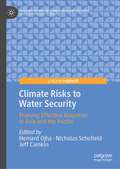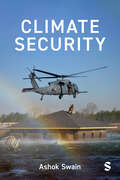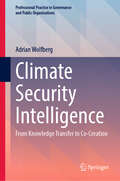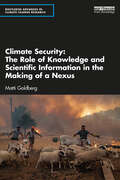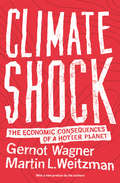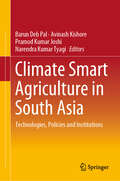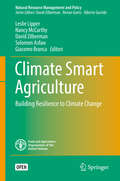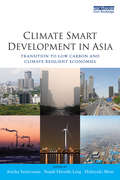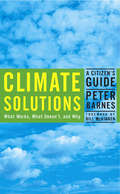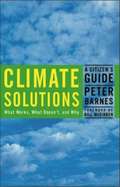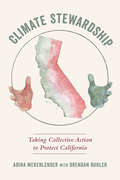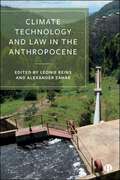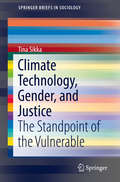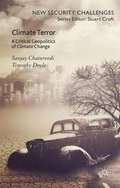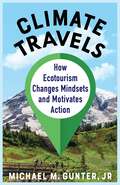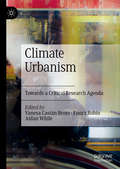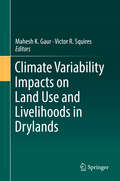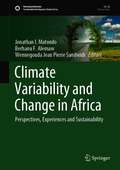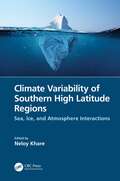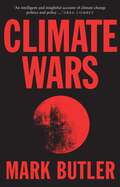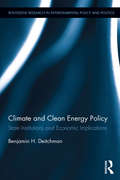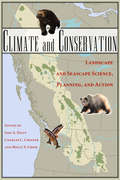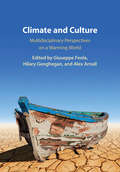- Table View
- List View
Climate Risks to Water Security: Framing Effective Response in Asia and the Pacific (Palgrave Studies in Climate Resilient Societies)
by Hemant Ojha Nicholas Schofield Jeff CamkinIn Asia and the Pacific, climate change is now a well-recognised risk to water security but responses to this risk are either under reported, or continue to be guided by the incremental or business as usual approaches. Water policy still tends to remain too narrow and fragmented, compared to the multi-sectoral and cross-scalar nature of risks to water security. What’s more, current water security debates tend to be framed in discipline specific or academic ways, failing to understand decision making and problem-solving contexts within which policy actors and partitioners have to operate on a daily basis. Much of the efforts to date has focussed on assessing and predicting the risks in the context of increasing levels of uncertainty. There is still limited analysis of emerging practices of risks assessment and mitigation in different contexts in Asia and the Pacific.Going beyond the national scales and focussing on several socio-ecological zones, this book captures stories written by engaged scholars on recent attempts to develop cross-sectoral and cross-scaler solutions to assess and mitigate risks to water security across Asia and the Pacific. Identifying lessons from successes and failures, it highlights management and strategic lessons that water and climate leaders of Asia and the Pacific need to consider. This book showcases reflective and analytical thought pieces written by key actors in the climate and water spaces. Several critical socio-ecological zones are covered – from Pakistan in the west to pacific islands in the east. The chapters clearly identify strategies for improvement based on the analysis of emerging responses to climate risks to water security and gaps in current practices. The book will include an editorial introduction and a final synthesis chapter to ensure clear articulation of common themes and to highlight the overall messages of the book.
Climate Security
by Ashok SwainHow does the climate crisis relate to global security issues? What impact do increasing temperatures, droughts, sea level rises and extreme weather have on borders, war, migration and unrest? This nuanced, urgent book cuts into the heart of this relationship, packed with global examples, from glacier movements destabilizing borders, to misinformation driving political apathy around the climate. You will encounter new, provocative ideas such as the carbon footprint of the military, the pressing need for the Global South to adapt, not blame, and the need for strong and visionary leadership in climate negotiations. Situated on the cutting edge of the climate debate, this book will revolutionize your perspective on global security, challenge deep-rooted assumptions and ignite you critical thinking.
Climate Security
by Ashok SwainHow does the climate crisis relate to global security issues? What impact do increasing temperatures, droughts, sea level rises and extreme weather have on borders, war, migration and unrest? This nuanced, urgent book cuts into the heart of this relationship, packed with global examples, from glacier movements destabilizing borders, to misinformation driving political apathy around the climate. You will encounter new, provocative ideas such as the carbon footprint of the military, the pressing need for the Global South to adapt, not blame, and the need for strong and visionary leadership in climate negotiations. Situated on the cutting edge of the climate debate, this book will revolutionize your perspective on global security, challenge deep-rooted assumptions and ignite you critical thinking.
Climate Security Intelligence: From Knowledge Transfer to Co-Creation (Professional Practice in Governance and Public Organizations)
by Adrian WolfbergClimate security intelligence is the capacity to warn national and sub-national security organizations of the physical effects of climate change that can have a negative societal effect on nations, governments, and their populations. This book discusses the uniqueness of climate security intelligence, the maturity of its development as a knowledge domain, and its possible future. Written by an intelligence analyst with over forty years of experience, this book centers upon the challenges that organizations may face when analysts, their managers, and their organizations are given the task of warning policymakers and decision-makers about threats to climate security. Taking a necessarily transdisciplinary approach, this book will be of interest to a wide audience of students, researchers, practitioners, and policy-makers concerned with how the impacts of climate change affect the social, cultural, political, and economic stability of national interests.
Climate Security: The Role of Knowledge and Scientific Information in the Making of a Nexus (Routledge Advances in Climate Change Research)
by Matti GoldbergThis book presents an empirical study of the role of knowledge in the making of the climate-security nexus. Climate change might give the Soviet Union a competitive advantage in the Cold War. Extreme droughts contributed to wars in Darfur, Syria or Yemen. Melting sea ice creates geopolitical risks. Russia’s climate-destroying hydrocarbons enabled its invasion of Ukraine. These are just some of the many ways in which climate change and conflicts have been linked into a climate-security nexus. In this innovative book, Matti Goldberg considers how such connections are constructed and asks to what extent they are driven by evidence and science. Goldberg describes the tools used to present the wars of Darfur and Syria as “climate wars” and considers the fragmented role of the sciences in those presentations as well as the resulting patterns of influence and marginalization of impacted populations. The author also highlights how the international community can better integrate the situations of people at the frontlines of climate change into policymaking and, based on an analysis of the dynamic nature of power, identifies potential entry points for positive change. This book is a must-read for researchers interested in climate-security links, in science-policy interfaces, and in the formation of nexuses of issues in international politics. It is also of interest to practitioners working on the climate-security nexus and science-policy interfaces.
Climate Shock
by Gernot Wagner Martin L. WeitzmanIf you had a 10 percent chance of having a fatal car accident, you'd take necessary precautions. If your finances had a 10 percent chance of suffering a severe loss, you'd reevaluate your assets. So if we know the world is warming and there's a 10 percent chance this might eventually lead to a catastrophe beyond anything we could imagine, why aren't we doing more about climate change right now? We insure our lives against an uncertain future--why not our planet?In Climate Shock, Gernot Wagner and Martin Weitzman explore in lively, clear terms the likely repercussions of a hotter planet, drawing on and expanding from work previously unavailable to general audiences. They show that the longer we wait to act, the more likely an extreme event will happen. A city might go underwater. A rogue nation might shoot particles into the Earth's atmosphere, geoengineering cooler temperatures. Zeroing in on the unknown extreme risks that may yet dwarf all else, the authors look at how economic forces that make sensible climate policies difficult to enact, make radical would-be fixes like geoengineering all the more probable. What we know about climate change is alarming enough. What we don't know about the extreme risks could be far more dangerous. Wagner and Weitzman help readers understand that we need to think about climate change in the same way that we think about insurance--as a risk management problem, only here on a global scale.Demonstrating that climate change can and should be dealt with--and what could happen if we don't do so--Climate Shock tackles the defining environmental and public policy issue of our time.
Climate Smart Agriculture in South Asia: Technologies, Policies and Institutions
by Barun Deb Pal Avinash Kishore Pramod Kumar Joshi Narendra Kumar TyagiThis book discusses various climate smart agro-technologies, their technical and economic feasibility across heterogeneous agro-climatic conditions, assessing farmers’ willingness to adopt those technologies, impact of climate smart technology in agricultural production and possible policy and investment opportunities to upscale it. Containing eight chapters, the book starts with a discussion about the methodological aspects of priority setting of the farm technologies across various regions of South Asia including Eastern Indo-Gangetic plain, Western Indo-Gangetic Plain and arid regions. Using data from field based trials and expert solicitations, the book next deliberates on a list of feasible technologies, assessed by constructing climate smart Feasibility Index. Further on, there is an analysis, using stated preference method, of the behaviour of farmers in adopting climate smart technologies. Preference of women farmers has been given a special focus in this book. After discussing the method priority setting of the farm technologies, impact of climate smart technologies has been analysed using real time data. Government policies have been reviewed with the view of achieving climate smart agriculture in South Asia. The book also describes the optimization modelling framework for investment allocation and technology prioritization. The model integrates both the bio-physical and the economic optimization model to capture the agro-climatic heterogeneity within the region and the variability of technical feasibility across regions and crops. Results of this model will help policy makers to identify how much to invest, where to invest and what technologies to prioritize for investments.
Climate Smart Agriculture: Building Resilience to Climate Change (Natural Resource Management and Policy #52)
by David Zilberman Leslie Lipper Nancy Mccarthy Solomon Asfaw Giacomo BrancaThis book is open access under a CC BY-NC-SA 3. 0 IGO license. The book uses an economic lens to identify the main features of climate-smart agriculture (CSA), its likely impact, and the challenges associated with its implementation. Drawing upon theory and concepts from agricultural development, institutional, and resource economics, this book expands and formalizes the conceptual foundations of CSA. Focusing on the adaptation/resilience dimension of CSA, the text embraces a mixture of conceptual analyses, including theory, empirical and policy analysis, and case studies, to look at adaptation and resilience through three possible avenues: ex-ante reduction of vulnerability, increasing adaptive capacity, and ex-post risk coping. The book is divided into three sections. The first section provides conceptual framing, giving an overview of the CSA concept and grounding it in core economic principles. The second section is devoted to a set of case studies illustrating the economic basis of CSA in terms of reducing vulnerability, increasing adaptive capacity and ex-post risk coping. The final section addresses policy issues related to climate change. Providing information on this new and important field in an approachable way, this book helps make sense of CSA and fills intellectual and policy gaps by defining the concept and placing it within an economic decision-making framework. This book will be of interest to agricultural, environmental, and natural resource economists, development economists, and scholars of development studies, climate change, and agriculture. It will also appeal to policy-makers, development practitioners, and members of governmental and non-governmental organizations interested in agriculture, food security and climate change.
Climate Smart Development in Asia: Transition to Low Carbon and Climate Resilient Economies
by Ancha Srinivasan Frank Hiroshi Ling Hideyuki MoriThe future of China, India and Asia’s other emerging economies and their ability to take a ‘low-carbon’ and ‘climate-resilient’ development path determine the future of global carbon emissions and climate change. Indeed, the battle to confront global climate change will be won or lost in Asia. The transition to a low-carbon, climate-resilient economy (LCE), which involves many steps towards improved energy efficiency, alternative energy sources and transport systems, sustainable land use, eco-friendly consumption and proactive adaptation, may be regarded as the world's fourth revolution, after the industrial revolution, agricultural revolution, and the information revolution. Asia is highly vulnerable to impacts of climate change. Yet because of its dynamic economies and massive populations, Asia offers the greatest opportunity for overcoming the trade-offs and pursuing low-carbon development pathways. With a growing consensus that there is limited time to avoid the worst impacts of climate change, scientists, engineers, policymakers, and economists across Asia have recently begun discussions on how Asia can make a transition to LCE. Most discussions, however, focused on transfer of technologies from developed to developing countries and overlooked other equally important challenges such as financing, governance, and information dissemination. This book is the first to look at these neglected aspects of LCE and attempt to integrate both market-based and technology-based solutions into a comprehensive strategy to creating a roadmap for LCE in Asia. This book is an essential reading for economists, policy makers, practitioners, engineers and researchers concerned with climate change, energy production and development in Asia and the impacts and potential for the world.
Climate Solutions
by Peter BarnesIn 2006, NASA's top climate scientist warned that we have at most a decade to turn the tide on global warming. After that, James Hansen said, all bets are off. Temperature rises of 3 to 7 degrees Farenheit will "produce a different planet. " If Hansen is right-and most scientists think he is-then every year lost is a year closer to the precipice. In more positive terms, we have one last chance-but one chance only-to save the planet. This guide is about that last chance. It's a result of hundreds of how-do-we-do-this-right discussions over many years. Author and entrepreneur Peter Barnes want to share what he's learned in these discussions because the climate crisis must be solved now, and popular understanding is a pre-requisite to getting a solution that actually solves the problem. As a result of these numerous discussions, Barnes come to appreciate that climate policy isn't as simple as one would want it to be. But it's not rocket science, either. When details get complicated, the key is to remember what we, as a nation and a species, must very quickly do: install a workable and lasting system for limiting our use of the atmosphere.
Climate Solutions: A Citizen's Guide
by Peter BarnesIn 2006, NASA's top climate scientist warned that we have at most a decade to turn the tide on global warming. After that, James Hansen said, all bets are off. Temperature rises of 3 to 7 degrees Fahrenheit will "produce a different planet." If Hansen is right--and most scientists think he is--then every year lost is a year closer to the precipice. In more positive terms, we have one last chance-but one chance only-to save the planet. This guide is about that last chance. It's a result of hundreds of how-do-we-do-this-right discussions over many years. Author and entrepreneur Peter Barnes want to share what he's learned in these discussions because the climate crisis must be solved now, and popular understanding is a prerequisite to getting a solution that actually solves the problem. As a result of these numerous discussions, Barnes come to appreciate that climate policy isn't as simple as one would want it to be. But it's not rocket science, either. When details get complicated, the key is to remember what we, as a nation and a species, must very quickly do: install a workable and lasting system for limiting our use of the atmosphere.
Climate Stewardship: Taking Collective Action to Protect California
by Adina MerenlenderAs climate disruption intensifies the world over, Californians are finding solutions across a diversity of communities and landscapes. Though climate change is a global existential threat, we cannot wait for nation-states to solve the problem when there are actions we can take now to protect our own communities. In Climate Stewardship: Taking Collective Action to Protect California, readers are invited on a journey to discover that all life is interconnected and shaped by climate and to learn how communities can help tackle climate change. Climate Stewardship shares stories from everyday people and shows how their actions enhance the resilience of communities and ecosystems across ten distinct bioregions. Climate science that justifies these actions is woven throughout, making it easy to learn about Earth's complex systems. The authors interpret and communicate these stories in a way that is enjoyable, inspiring, and even amusing. California is uniquely positioned to develop and implement novel solutions to widespread climate challenges, owing to the state's remarkable biogeographic diversity and robust public science programs. Produced in collaboration with the UC California Naturalist Program, Climate Stewardship focuses on regenerative approaches to energy, agriculture, and land and water use across forested, agricultural, and urban landscapes. The authors' hopeful and encouraging tone aims to help readers develop a sense that they, too, can act now to make meaningful change in their communities.
Climate System Dynamics and Modelling
by Hugues GoosseThis textbook presents all aspects of climate system dynamics, on all timescales from the Earth's formation to modern human-induced climate change. It discusses the dominant feedbacks and interactions between all the components of the climate system: atmosphere, ocean, land surface and ice sheets. It addresses one of the key challenges for a course on the climate system: students can come from a range of backgrounds. A glossary of key terms is provided for students with little background in the climate sciences, whilst instructors and students with more expertise will appreciate the book's modular nature. Exercises are provided at the end of each chapter for readers to test their understanding. This textbook will be invaluable for any course on climate system dynamics and modeling, and will also be useful for scientists and professionals from other disciplines who want a clear introduction to the topic.
Climate Technology and Law in the Anthropocene
by Leonie Reins and Alexander ZaharAvailable open access digitally under CC-BY-NC-ND licence. As climate change accelerates, our window for action is closing. To stay within the "Anthropocene" - an epoch in which humankind as the dominant force shaping the planet retains a degree of control over the destructive processes it has unleashed - global warming must be kept below 2° Celsius. This book explores the unprecedented technological and legal changes required to achieve this. Featuring contributions from leading experts, the essays examine the intersection of technology, law, and environmental values, offering diverse viewpoints on navigating the Anthropocene. Revealing the controversies of rapid technological adoption and legal reform, this is a crucial analysis of a complex future whose many dangers for our society are barely understood.
Climate Technology, Gender, and Justice: The Standpoint Of The Vulnerable (Springerbriefs In Sociology Ser.)
by Tina SikkaThis book is the first to undertake a gendered analysis of geoengineering and alternative energy sources. Are either of these technologies sufficiently attendant to gender issues? Do they incorporate feminist values as articulated by the renowned social philosopher Helen Longino, such as empirical adequacy, novelty, heterogeneity, complexity and applicability to human needs? The overarching argument in this book contends that, while mitigation strategies like solar and wind energy go much further to meet feminist objectives and virtues, geoengineering is not consistent with the values of justice as articulated in Longino's feminist approach to science. This book provides a novel, feminist argument in support of pursuing alternative energy in the place of geoengineering. It provides an invaluable contribution for academics and students working in the areas of gender, science and climate change as well as policy makers interested in innovative ways of taking up climate change mitigation and gender.
Climate Terror
by Timothy Doyle Sanjay ChaturvediClimate Terror investigates the highly differentiated geographical politics of global warming. It explores how fear-inducing climate change discourses could result in new forms of dependencies, domination and militarized 'climate security'. In this revealing study from Chaturvedi and Doyle, the concept of environmental security is brought to life through cases of the most pressing environmental issues confronting the Global South, which are creating desperate realities for billions of people. The book proposes the following key questions, crucial to our understanding of this issue: Can the climate discourse be re-configured to provide a place where issues of environmental justice and sovereignty are paramount, rather than neo-liberal responses to climate? Can climate change give a voice to the global periphery, and can it be used as a vehicle for emancipation? Chaturvedi and Doyle's study concludes by taking note of the more optimistic response of 'emancipatory' groups and networks to concepts such as climate justice and climate debt, and the ways in which these groups have attempted to use this global climate moment for more democratic purposes. Is the climate story, regardless of its diverse intentions, a discourse now captured by the affluent North to control the development of the Global South? Has the emancipatory moment now passed or is there still hope for the re-emergence of subaltern perspectives on climate futures? The authors further discuss the deployment of terror vocabulary to address climate change, which is a part of refurbished designs and technologies of control, regulation and domination in a neo-liberal, post-political, globalized world marked by profound asymmetries in terms of economic growth and human development. They argue for an increased understanding of the environment, not as an external enemy force, but as adiverse nature that is inclusive of people, a nature that has the potential to provide secure access to citizens of all countries to basic nutrition, adequate access to health, appropriate shelter, and a security to practice a diverse range of livelihoods.
Climate Travels: How Ecotourism Changes Mindsets and Motivates Action
by Michael M. Gunter Jr.Many accounts of climate change depict disasters striking faraway places: melting ice caps, fearsome hurricanes, all-consuming fires. How can seeing the consequences of human impacts up close help us grasp how global warming affects us and our neighbors? This book is a travelogue that spotlights what a changing climate looks like on the local level—for wherever local happens to be.Michael M. Gunter, Jr. takes readers around the United States to bear witness to the many faces of the climate crisis. He argues that conscientious travel broadens understanding of climate change and makes its dangers concrete and immediate. Vivid vignettes explore the consequences for people and communities: sea level rise in Virginia, floods sweeping inland in Tennessee, Maine lobsters migrating away from American territorial waters, and imperiled ecosystems in national parks, from Alaskan permafrost to the Florida Keys. But Gunter finds inspiring initiatives to mitigate and adapt to these threats, including wind turbines in a tiny Texas town, green building construction in Kansas, and walkable urbanism in Portland, Oregon. These projects are already making a difference—and they underscore the importance of local action.Drawing on interviews with government officials, industry leaders, and alternative energy activists, Climate Travels emphasizes direct personal experience and the centrality of environmental justice. Showing how travel can help bring the reality of climate change home, it offers readers a hopeful message about how to take action on the local level themselves.
Climate Urbanism: Towards a Critical Research Agenda
by Vanesa Castán Broto Enora Robin Aidan WhileThis book argues that the relationship between cities and climate change is entering a new and more urgent phase. Thirteen contributions from a range of leading scholars explore the need to rethink and reorient urban life in response to climatic change. Split into four parts it begins by asking ‘What is climate urbanism?’ and exploring key features from different locations and epistemological traditions. The second section examines the transformative potential of climate urbanism to challenge social and environmental injustices within and between cities. In the third part authors interrogate current knowledge paradigms underpinning climate and urban science and how they shape contemporary urban trajectories. The final section focuses on the future, envisaging climate urbanism as a new communal project, and focuses on the role of citizens and non-state actors in driving transformative action. Consolidating debates on climate urbanism, the book highlights the opportunities and tensions of urban environmental policy, providing a framework for researchers and practitioners to respond to the urban challenges of a radically climate-changed world.
Climate Variability Impacts on Land Use and Livelihoods in Drylands
by Victor R. Squires Mahesh K. GaurThis edited volume is devoted to the examination of the implications of the inevitable changes wrought by global change on the welfare and livelihoods of tens of millions of people who live in dryland regions. Global change is more than just climate change and the ramifications of changing trade patterns (geopolitical and economic aspects), the shift to the market economy, demographic factors (population growth, urbanization and re-settlement), receive attention here. Land use change specialists, policy makers and natural resource management agencies will find the book very useful.Chapters focus on examples that are drawn from a number of sources including previously unpublished studies on the impact of climate change, markets and economics on pastoralist and dryland farming households. The key focus is to provide readers with insights into the real world implications of change (including an analysis of the drivers of change) on these vulnerable groups within dryland societies. The role of humans as agents of these changes is canvassed. A regional analysis of the world's drylands is also performed including those in Australia, Argentina, India, North America, China, North Africa, Central Asia and Southern Africa.
Climate Variability and Change in Africa: Perspectives, Experiences and Sustainability (Sustainable Development Goals Series)
by Jonathan I. Matondo Berhanu F. Alemaw Wennegouda Jean Pierre SandwidiThis book presents a comprehensive overview of climate variability and change in Africa, and includes impact assessments and case studies from integration frameworks, with a particular focus on climate, agriculture and water resources. Richly illustrated, the book highlights case studies from western, eastern and southern African region, and explores related development policies. Climate change adaptation research, prediction, and reanalysis are also addressed
Climate Variability of Southern High Latitude Regions: Sea, Ice, and Atmosphere Interactions
by Neloy KhareThis is the first book to provide a comprehensive overview of climate change–related investigations carried out by Indian researchers through initiatives in southern high latitude regions. It explains climate variability over the Southern Ocean and Antarctica; air, sea, ice, and atmosphere interactions; and the impact of climate variability on sea ice and the polar atmosphere. The data were gathered at two Indian research bases, Maitri and Bharti, which are ideal sites to study and understand climatic evolution in Antarctic in the past and recent changes. This book helps to understand climatological perspectives and to evaluate some of the most pressing issues in the south polar region. FEATURES Highlights the achievements of India in the contemporary field of Antarctic climatology Presents four decades of research by Indian scientists in Antarctica, which is now shared for the first time with the global community Includes case studies on climatological and environmental conditions of natural archives to shed light on climate scenarios in the Southern Ocean and Antarctic regions Covers various aspects of climate variability and induced air-sea-ice-atmosphere interactions This book is edited by one of the top scientists and researchers of India in the field of paleoclimatology, and the contributors are experts in the Antarctic region.
Climate Wars
by Mark ButlerAs the consequences of climate change become perilously close to the point of no-return, time-wasting wars over what to do distract us from taking real action.Mark Butler, the opposition minister for climate change and energy, makes a forceful case for using less and cleaner energy as part of global action to save the planet. Doing so will also make Australia attractive for the massive global market of investors and create new jobs in clean energy.Climate Wars argues that only Labor, the party with a proven track record for national reform, has the plan and the will to ensure bold action before it is too late.
Climate and Clean Energy Policy: State Institutions and Economic Implications (Routledge Research in Environmental Policy and Politics)
by Benjamin H. DeitchmanState climate and clean energy policy will play a critical role in the future of the political dialogue and economic development. Policymakers from around the world already recognize the leadership of American states in this domain. Rooted in public policy theory, and employing a mixed-methods approach that includes advanced economic analysis and qualitative research, Benjamin H. Deitchman explores the policy tools that address the politics and economics of clean energy development and deployment across all 50 states. Deitchman includes in his analysis international case studies of this policy context in Canada, Germany, and Australia to reveal different state-level policy tools, the politics behind the tools, and the economic implications of alternative approaches. The rigorous analysis of the politics of state level institutions and economic implications of subnational climate and clean energy actions offers researchers, students, and policymakers with practical information to advance their understanding of these options in the policy process.
Climate and Conservation: Landscape and Seascape Science, Planning, and Action
by Charles C. Chester Molly S. Cross Jodi A. HiltyClimate and Conservation presents case studies from around the world of projects focused on climate change adaptation-regional-scale endeavors where scientists, managers, and practitioners are working to protect biodiversity by protecting landscapes and seascapes in response to threats posed by climate change. The book begins with an introductory section that frames the issues and takes a systematic look at planning for climate change adaptation. The nineteen chapters that follow examine particular case studies in every part of the world, including landscapes and seascapes from equatorial, temperate, montane, polar, and marine and freshwater regions. Climate and Conservation offers readers tangible, place-based examples of projects designed to protect large landscapes as a means of conserving biodiversity in the face of the looming threat of global climate change.
Climate and Culture: Multidisciplinary Perspectives on a Warming World
by Giuseppe Feola Hilary Geoghegan Alex ArnallHow does culture interact with the way societies understand, live with, and act in relation to climate change? While the importance of the exchanges between culture, society and climate in the context of global environmental change is increasingly recognised, the empirical evidence is fragmented and too often constrained by disciplinary boundaries. Written by an international team of experts, this book provides cutting-edge and critical perspectives on how culture both facilitates and inhibits our ability to address and make sense of climate change and the challenges it poses to societies globally. Through a set of case studies spanning the social sciences and humanities, it explores the role of culture in relation to climate and its changes at different temporal and spatial levels; illustrates how approaching climate change through the cultural dimension enriches the range and depth of societal engagements; and establishes connections between theory and practice, which can stimulate action-oriented initiatives.
